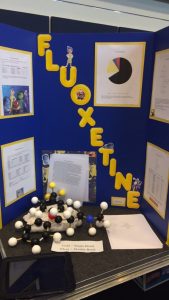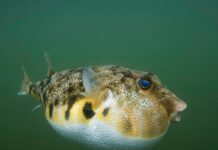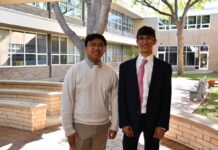Okay. While poison and acid may not have been in there, their molecular structures were. Rows upon rows of styrofoam ball-and-stick models in front of colorful tri-fold poster boards covered the blue carpet, adding up to more than 270 projects total.
On April 18th and 19th, sophomore chemistry students displayed their completed molecule projects. Each student was given their own unique molecule, ranging from tetrahydrocannabinol to buckminsterfullerene. In the weeks preceding their presentations, students completed various parts of the project: molecule characteristics, structure, function, etc. Finally, they constructed 3D models of their molecules, most using painted styrofoam balls for atoms and small wooden sticks as bonds, although some others made use of “gumball atoms.” The inventor of this unique structure, Will Fynes ’18, said, “I thought it was interesting to see different elements…come together.”
Because every student in the whole sophomore class was assigned a different molecule, there was a plethora of different substances to discover last week. Fynes remarked, “There was definitely an opportunity to learn about some molecules that you didn’t even know existed.” And those aforementioned poisons and acids were among the molecules, so this project was anything but boring for the students  who researched them. Sophomore Marc Veloz stated, “It was a meaningful project because it helped me learn a lot about my molecule, which I never would have learned about if I didn’t researched it.”
who researched them. Sophomore Marc Veloz stated, “It was a meaningful project because it helped me learn a lot about my molecule, which I never would have learned about if I didn’t researched it.”
Yet, no one said that the molecules were easy to build. “Putting that molecule [model] together was definitely tricky.” Fynes joked, “It took a good chunk out of my Sunday!” Although the molecules needn’t exceed 50 square centimeters, a few students greatly surpassed that project requirement, with some molecules not even fitting on the tables.
The second half of the final product was the poster board. Students could be as creative as they wanted with their tri-folds, and the general consensus was that this half of the project was easier than constructing the molecular model. However, if your molecule was relatively unknown it made your project a lot more difficult. Experiencing this roadblock, Carter Elliot ’18 commented, “There was almost no  research on [my molecule]…It’s not even FDA approved.” But with the research done in the initial stages of the project, poster board assembly could as simple as gluing the elements to the board. As always, some students did go above and beyond, evidenced by the poster that lit up with Christmas lights and others with various apparatuses to hang the models.
research on [my molecule]…It’s not even FDA approved.” But with the research done in the initial stages of the project, poster board assembly could as simple as gluing the elements to the board. As always, some students did go above and beyond, evidenced by the poster that lit up with Christmas lights and others with various apparatuses to hang the models.
Students like John Bowen ’18 were proud of the work that they put into the major project. “It was very satisfying when you finished it,” he remarked. The teachers also loved the finished products and are looking forward to next year’s round of projects!






